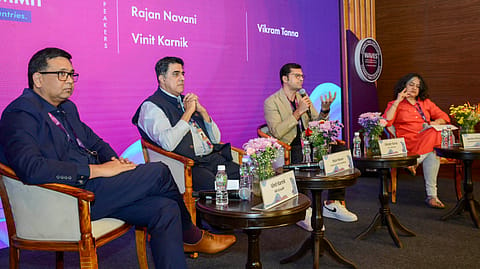AI-led monetisation needs scale, human insight and patience, says GroupM's Vinit Karnik
GroupM's Vinit Karnik stresses the importance of balancing AI adoption with the need for humanised storytelling and measurable business outcomes.

As India advances toward its Viksit Bharat @ 2047 vision, the future of the country's media and entertainment industry will depend not just on artificial intelligence or broader technological shifts, but on a mature and scalable monetisation strategy.
Speaking at WAVES 2025 in Mumbai on Thursday, Vinit Karnik, MD of GroupM, addressed a key question on AI’s role in enhancing content quality and driving monetisation. He stressed the importance of balancing AI adoption with the need for humanised storytelling and measurable business outcomes.
“Monetisation is a much more mature stage of marketing. The question is how you monetise—do we have an answer? Because when it comes to volatile income scaling and how we achieve scale, we will have to keep experimenting to reach it,” says Karnik.
The panel, titled “Indian M&E @100: Reimagining the Future of Media and Entertainment,” featured Rajan Navani, Founder and CEO of JetSynthesys, and Vikram Tanna, CEO of Eros Now. It was moderated by Vanita Kohli Khandekar, contributing editor at Business Standard.
Karnik underlined that while AI is revolutionising how ads are created, potentially reducing costs for small businesses and MSMEs, it must still be rooted in purpose. Gone are the days of making a handful of 30-second TVCs a year. Today’s consumer engages with content on mobile, on the move. He emphasised that agencies need AI tools that allow brands to create hyper-personalised, meaningful content at scale without losing the human touch.
For Karnik, this aligned closely with the perspective shared by his global parent company WPP’s CEO, Mark Read. In his keynote address, Read highlighted the advertising industry’s global value of one trillion dollars and its ongoing transformation through AI-driven storytelling. Read revealed that WPP is currently leveraging its WPP Open platform along with WPP AI, built in collaboration with Google’s technology infrastructure.
With 60% of the advertising pie now digital, Karnik said the industry needs to focus on using AI as a creative accelerator rather than a replacement. He cited a real-time augmented reality (AR) campaign executed in a Bengaluru retail store, where AI-assisted shoppers identified and purchased products via interactive mobile experiences. The question, thus, is—how do enterprises scale AI meaningfully and monetise it in a country where price-performance still drives consumer behaviour?
Recommended Stories
Echoing Karnik’s views, Navani pointed to broader economic realities. Addressing Vanita’s concerns on monetisation, he pointed out the relatively low disposable income in India compared to developed markets but expressed optimism that sustained economic growth will boost consumer spending. With India’s per capita GDP still relatively low compared to developed markets, consumer spending on entertainment remains limited. However, there is optimism that a decade of 10% annual growth could unlock significant monetisation potential. “India’s scale is its biggest asset. But it requires disproportionate investment upfront—only then will monetisation follow,” Navani adds.
Karnik added that the storytelling power of AI can also unlock new advertising formats. “With prompt engineering courses starting at institutions like Mumbai University, we’re preparing for a future where anyone can brief AI to create a compelling campaign,” he said. “But the messaging, the cultural nuance, must still come from human insight.”
He urged the industry to adopt a blended model where technology is an enabler, not a substitute. “If we want to build culturally rooted, creatively rich content ecosystems, we must focus on AI as a tool that supports—not replaces—our imagination.”